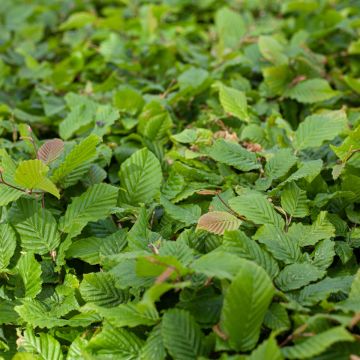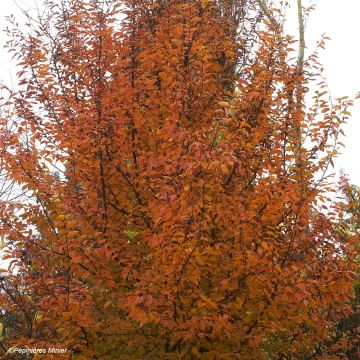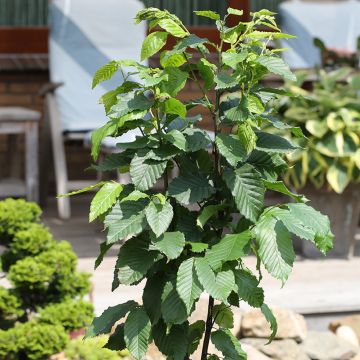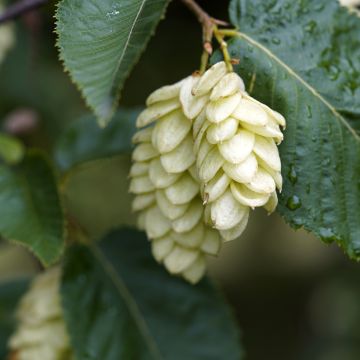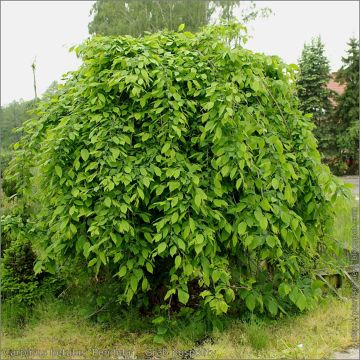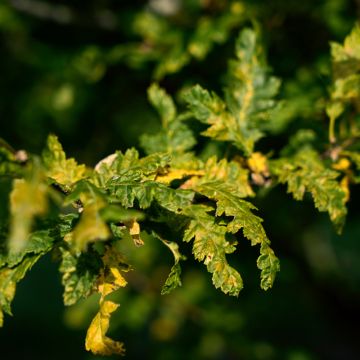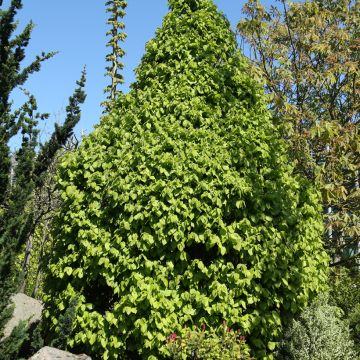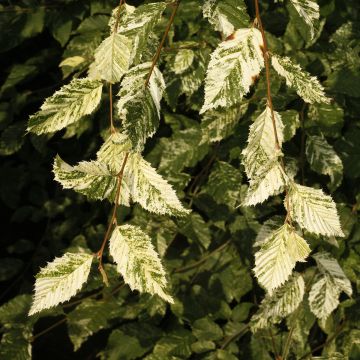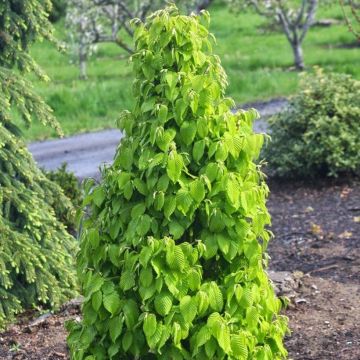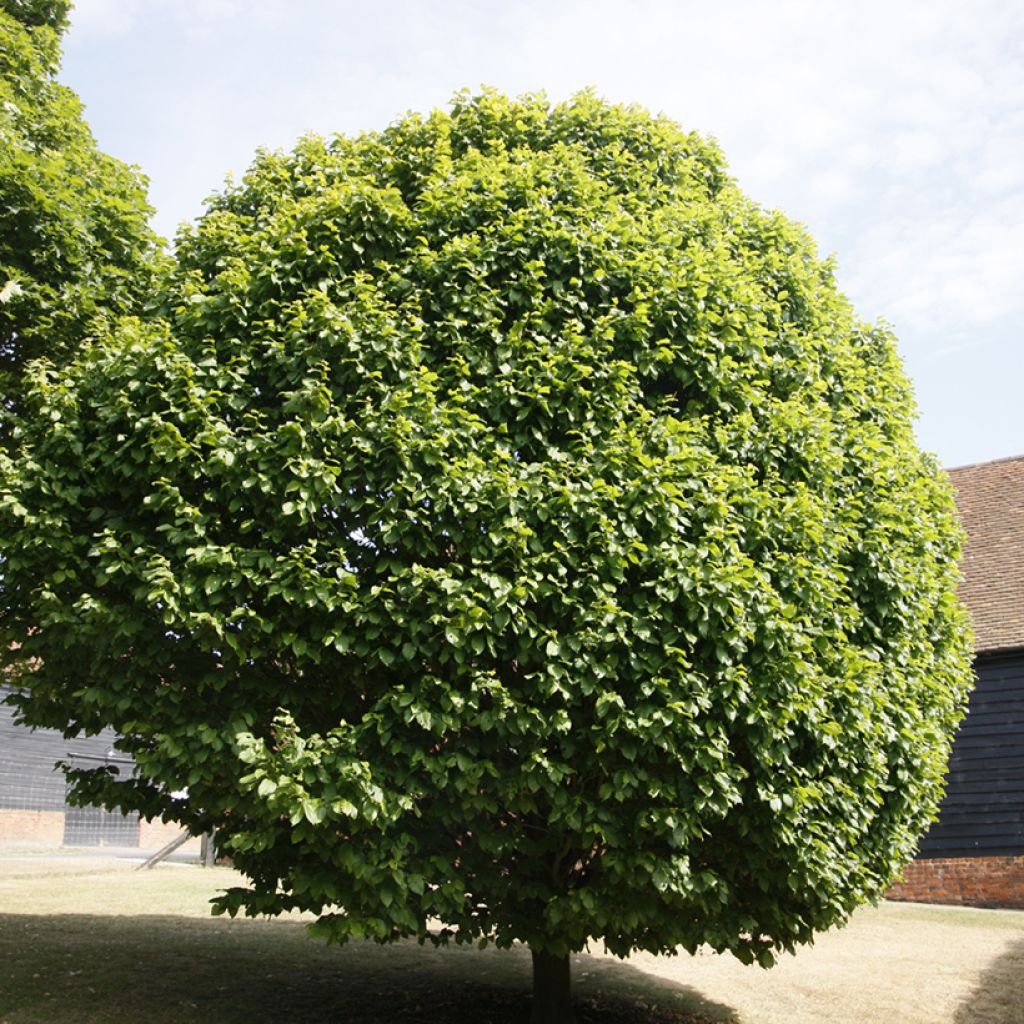

Carpinus betulus Columnaris - Hornbeam
Carpinus betulus Columnaris - Hornbeam
Carpinus betulus Columnaris
Common Hornbeam
Why not try an alternative variety in stock?
View all →This plant carries a 24 months recovery warranty
More information
We guarantee the quality of our plants for a full growing cycle, and will replace at our expense any plant that fails to recover under normal climatic and planting conditions.
From €5.90 for pickup delivery and €6.90 for home delivery
Express home delivery from €8.90.
Does this plant fit my garden?
Set up your Plantfit profile →
Description
The Carpinus betulus 'Columnaris' is a cultivar of Hornbeam or Fastigiate Hornbeam with an extremely slow growth and a compact habit. Its crown, initially ovoid and slender, becomes denser over time. Its trunk is often cleared of branches at the base to highlight this dense and regular crown. This Hornbeam is more slender than the cultivar 'Fastigiata', with which it is often confused. Its leaves turn golden yellow in autumn and remain attached to the branches for quite some time before falling. The elegance of its well-defined silhouette will be appreciated in a French-style garden, a contemporary setting, or in a row to emphasise a grand alley. Like the Hornbeam found in our forests, this cultivar is also hardy and easy to grow.
The Carpinus betulus 'Columnaris' will eventually reach a height of about 8m with a spread of 3m. The trunk, very straight, is covered with a pale grey to greenish-grey bark. It is smooth on young subjects and cracks as it ages. Its flowers are either male or female, they have a slightly different appearance and appear at two distinct periods on the tree: the male catkins are visible in autumn and the female catkins in spring. The Carpinus betulus produces hanging clusters of fruits, 3 to 6 cm long, green in colour, which turn yellow-brown when mature, in late September. These fruits are called samaras and are toxic. The foliage is composed of ovate, doubly toothed leaves, 7 to 12 cm long. Its colour is a light green from spring to summer, turning golden yellow in autumn and then taking on a tobacco tone. To differentiate the leaves of a Hornbeam from those of a Beech, which are often confused, it's very simple! Hornbeam leaves are thin and dentate along the edges, while Beech leaves are hairy and thick.
The 'Columnaris' Hornbeam is a very robust plant that adapts to any sufficiently deep soil, even fairly dry. It is most often used as a solitary specimen in gardens of all sizes. It can be surrounded by evergreen shrubs such as Lonicera nitida 'Garden Clouds Purple Storm', Fargesia 'Moontears' bamboo, Ilex crenata 'Convexa', or other boxwood alternatives.
The wood of the Hornbeam is used for heating, papermaking, as well as for tools and children's toys. It is a shrub that rarely lives for more than 100 years in nature.
Report an error about the product description
Plant habit
Flowering
Foliage
Safety measures
Botanical data
Carpinus
betulus
Columnaris
Betulaceae
Common Hornbeam
Cultivar or hybrid
atteinterespiratoire
Cette plante peut entraîner des symptômes allergiques.
Evitez de la planter si vous ou vos proches souffrez de rhinite saisonnière ("rhume des foins").
Davantage d'informations sur https://plantes-risque.info
Other Carpinus - Hornbeam
Planting and care
Carpinus betulus 'Columnaris' can be planted in spring or autumn. It particularly appreciates cool, semi-shaded locations, but can also thrive in non-scorching sunlight. Place it sheltered from cold, drying winds in any type of well-drained soil. However, it is sensitive to acidic soils. Common Hornbeam is resistant to cold and heat, but does not tolerate summer heatwaves, especially when the soil lacks depth. It can be susceptible to coral disease and can be invaded by caterpillars and aphids. Occasionally, attacks from mites and diseases such as powdery mildew or foliar spots are observed in poor growing conditions.
Planting period
Intended location
Care
This item has not been reviewed yet - be the first to leave a review about it.
Trees for small gardens
Haven't found what you were looking for?
Hardiness is the lowest winter temperature a plant can endure without suffering serious damage or even dying. However, hardiness is affected by location (a sheltered area, such as a patio), protection (winter cover) and soil type (hardiness is improved by well-drained soil).

Photo Sharing Terms & Conditions
In order to encourage gardeners to interact and share their experiences, Promesse de fleurs offers various media enabling content to be uploaded onto its Site - in particular via the ‘Photo sharing’ module.
The User agrees to refrain from:
- Posting any content that is illegal, prejudicial, insulting, racist, inciteful to hatred, revisionist, contrary to public decency, that infringes on privacy or on the privacy rights of third parties, in particular the publicity rights of persons and goods, intellectual property rights, or the right to privacy.
- Submitting content on behalf of a third party;
- Impersonate the identity of a third party and/or publish any personal information about a third party;
In general, the User undertakes to refrain from any unethical behaviour.
All Content (in particular text, comments, files, images, photos, videos, creative works, etc.), which may be subject to property or intellectual property rights, image or other private rights, shall remain the property of the User, subject to the limited rights granted by the terms of the licence granted by Promesse de fleurs as stated below. Users are at liberty to publish or not to publish such Content on the Site, notably via the ‘Photo Sharing’ facility, and accept that this Content shall be made public and freely accessible, notably on the Internet.
Users further acknowledge, undertake to have ,and guarantee that they hold all necessary rights and permissions to publish such material on the Site, in particular with regard to the legislation in force pertaining to any privacy, property, intellectual property, image, or contractual rights, or rights of any other nature. By publishing such Content on the Site, Users acknowledge accepting full liability as publishers of the Content within the meaning of the law, and grant Promesse de fleurs, free of charge, an inclusive, worldwide licence for the said Content for the entire duration of its publication, including all reproduction, representation, up/downloading, displaying, performing, transmission, and storage rights.
Users also grant permission for their name to be linked to the Content and accept that this link may not always be made available.
By engaging in posting material, Users consent to their Content becoming automatically accessible on the Internet, in particular on other sites and/or blogs and/or web pages of the Promesse de fleurs site, including in particular social pages and the Promesse de fleurs catalogue.
Users may secure the removal of entrusted content free of charge by issuing a simple request via our contact form.
The flowering period indicated on our website applies to countries and regions located in USDA zone 8 (France, the United Kingdom, Ireland, the Netherlands, etc.)
It will vary according to where you live:
- In zones 9 to 10 (Italy, Spain, Greece, etc.), flowering will occur about 2 to 4 weeks earlier.
- In zones 6 to 7 (Germany, Poland, Slovenia, and lower mountainous regions), flowering will be delayed by 2 to 3 weeks.
- In zone 5 (Central Europe, Scandinavia), blooming will be delayed by 3 to 5 weeks.
In temperate climates, pruning of spring-flowering shrubs (forsythia, spireas, etc.) should be done just after flowering.
Pruning of summer-flowering shrubs (Indian Lilac, Perovskia, etc.) can be done in winter or spring.
In cold regions as well as with frost-sensitive plants, avoid pruning too early when severe frosts may still occur.
The planting period indicated on our website applies to countries and regions located in USDA zone 8 (France, United Kingdom, Ireland, Netherlands).
It will vary according to where you live:
- In Mediterranean zones (Marseille, Madrid, Milan, etc.), autumn and winter are the best planting periods.
- In continental zones (Strasbourg, Munich, Vienna, etc.), delay planting by 2 to 3 weeks in spring and bring it forward by 2 to 4 weeks in autumn.
- In mountainous regions (the Alps, Pyrenees, Carpathians, etc.), it is best to plant in late spring (May-June) or late summer (August-September).
The harvesting period indicated on our website applies to countries and regions in USDA zone 8 (France, England, Ireland, the Netherlands).
In colder areas (Scandinavia, Poland, Austria...) fruit and vegetable harvests are likely to be delayed by 3-4 weeks.
In warmer areas (Italy, Spain, Greece, etc.), harvesting will probably take place earlier, depending on weather conditions.
The sowing periods indicated on our website apply to countries and regions within USDA Zone 8 (France, UK, Ireland, Netherlands).
In colder areas (Scandinavia, Poland, Austria...), delay any outdoor sowing by 3-4 weeks, or sow under glass.
In warmer climes (Italy, Spain, Greece, etc.), bring outdoor sowing forward by a few weeks.

































